Co-Firing Combustion Characteristics of Woodchips and Spent Mushroom Substrates in a 400 kWth Stoker-Type Boiler
Abstract
:1. Introduction
2. Materials and Methods
3. Results
3.1. Characteristics of Woodchips and Spent Mushroom Substrate
3.2. Combustion Test—Woodchips (First Experiment)
3.3. Combustion Test—Co-Firing of Woodchips and Spent Mushroom Substrate (Second Experiment)
4. Discussion
5. Conclusions
- The water content of raw SMS is approximately 66%, so a drying process is necessary to decrease the water content to less than 20%;
- The SMS have poor fuel characteristics, especially ash (14.8%), nitrogen (2.6%), sulfur (0.21%) and net calorific value (2664 kcal/kg), compared to woodchips;
- Due to the higher value of the nitrogen content in SMS, the NOx emissions in the flue gas are much higher (143 ppm) than those encountered in the woodchip combustion condition (64 ppm);
- For water content up to approximately 20% in the SMS (30%) mixed with woodchips (70%), co-firing combustion has possibilities for use in industrial woodchip boilers. For scenarios in which the water content of SMS is greater than 20%, co-firing could be very unstable;
- In the future, it will be necessary to study the combustion of pure SMS;
- If the moisture content of SMS is less than 20%, the possibility of using SMS as a fuel a boiler co-fired with woodchips or wood pellets was confirmed;
- If SMS is dried to a moisture content of about 20%, the possibility of using it in a boiler together with woodchips or wood pellets was confirmed.
Author Contributions
Funding
Data Availability Statement
Conflicts of Interest
References
- Awan, M.B.; Iqbal, T.; Yaseen, S.; Nawaz, S.; Ali, C.H. Techno-economic sustainability analysis of biomass fired industrial boiler: Biomass evolution as heat and power generation source. IET Renew. Power Gener. 2019, 13, 650–658. [Google Scholar] [CrossRef]
- Saidur, R.; Abdelaziz, E.A.; Demirbas, A.; Hossaini, M.S.; Mekhilef, S. A review on biomass as a fuel for boilers. Renew. Sustain. Energy Rev. 2011, 15, 2262–2289. [Google Scholar] [CrossRef]
- Qiu, G. Testing of flue gas emissions of a biomass pellet boiler and abatement of particle emissions. Renew. Energy 2013, 50, 94–102. [Google Scholar] [CrossRef]
- Rabacal, M.; Fernandes, U.; Costa, M. Combustion and emission characteristics of a domestic boiler fired with pellets of pine industrial wood wastes and peach stones. Renew. Energy 2013, 51, 220–226. [Google Scholar] [CrossRef]
- Karen, N.F.; Changkook, R.; Vida, N.S.; Jim, S. The reuse of spent mushroom compost and coal tailings for energy recovery: Comparison of thermal treatment technologies. Bioresour. Technol. 2009, 100, 310–315. [Google Scholar]
- Bhupendra, K.; Mohammad, Y.; Maulin, P.S. Agricultural waste management strategies for environmental sustainability. Environ. Res. 2022, 206, 112285. [Google Scholar] [CrossRef]
- Kang, S.B.; Oh, H.Y.; Kim, J.J.; Choi, K.S. Characteristics of spent coffee ground as a fuel and combustion test in a small boiler (6.5 kW). Renew. Energy 2017, 113, 1208–1214. [Google Scholar] [CrossRef]
- Da Silva Alves, L.; De Almeida Moreira, B.R.; Da Silva Viana, R.; Pardo-Gimenez, A.; Dias, E.S.; Noble, R.; Zied, D.C. Recycling spent mushroom substrate into fuel pellets for low-emission bioenergy producing systems. J. Clean. Prod. 2021, 313, 127875. [Google Scholar] [CrossRef]
- Limousy, L.; Jeguirim, M.; Dutournie, P.; Kraiem, N.; Lajili, M.; Said, R. Gaseous products and particulate matter emissions of biomass residential boiler fired with spent coffee grounds pellets. Fuel 2013, 107, 323–329. [Google Scholar] [CrossRef]
- Dias, J.; Costa, M.; Azevedo, J.L. Test of a small domestic boiler using different pellets. In Proceedings of the World Conference on Pellets, Stockholm, Sweden, 2–4 September 2002; Volume 1, pp. 137–142. [Google Scholar]
- Verma, V.K.; Bram, S.; Gauthier, G.; De Ruyck, J. Performance of a domestic pellet boiler as a function of operational loads: Part-2. Biomass Bioenergy 2011, 35, 272–279. [Google Scholar] [CrossRef]
- Kortelainen, A.; Joutsensaari, J.; Hao, L.; Leskinen, J.; Titta, P.; Jaatinen, A.; Miettinen, P.; Sippula, O.; Torvela, T.; Tissari, J. Real time chemical composition analysis of particulate emissions from woodchip combustion. Energy Fuels 2015, 29, 1143–1150. [Google Scholar] [CrossRef]
- Caposciutti, G.; Barontini, F.; Galletti, C.; Antonelli, M.; Tognotti, L.; Desideri, U. Woodchip size effect on combustion tempera tures and volatiles in a small-scale fixed bed biomass boiler. Renew. Energy 2020, 151, 161–174. [Google Scholar] [CrossRef]
- Varol, M.; Atimtay, A.T.; Olgun, H. Emission characteristics of co-combustion of a low calorie and high-sulfur-lignite coal and woodchips in a circulating fluidized bed combustor: Part 2. Effect of secondary air and its location. Fuel 2014, 130, 1–9. [Google Scholar] [CrossRef]
- Deng, B.; Shi, Y.; Zhang, L.; Fang, H.; Gao, Y.; Luo, L.; Feng, W.; Hu, X.; Wan, S.; Huang, W.; et al. Effects of spent mushroom substrate-derived biochar on soil CO2 and N2O emissions depend on pyrolysis temperature. Chemosphere 2020, 246, 125608. [Google Scholar] [CrossRef]
- Xu, X.; Yuan, X.; Zhang, Q.; Wei, Q.; Liu, X.; Deng, W.; Wang, J.; Yang, W.; Deng, B.; Zhang, L. Biochar derived from spent mushroom substrate reduced N2O emissions with lower water content but increased CH4 emissions under flooded condition from fertilized soils in Camellia oleifera plantations. Chemosphere 2022, 287, 132110. [Google Scholar] [CrossRef]
- Tillman, D.A.; Plasynski, S.; Hughes, E. Biomass cofiring in coal-fired boilers: Test programs and results. In Proceedings of the Biomass Conference of the Americas, Oakland, CA, USA, 29 August–2 September 1999; Volume 2, pp. 1287–1292. [Google Scholar]
- Shen, L. Emission characteristics of carbonyl compounds emitted from biomass-fired-boilers. China Environ. Sci. 2019, 39, 490–498. [Google Scholar]
- Lv, W.; Zhang, X.N.; LI, R.Y.; Zhao, Z.X.; Lin, X.Y.; Cheng, C.; Han, J.W. Biomass boiler exhaust gas temperature factors Analysis. Adv. Mater. Res. 2014, 865–867, 1981–1984. [Google Scholar] [CrossRef]
- Chandrasekaran, S.R.; Hopke, P.K.; Newtown, M.; Huribut, A. Residential-scale biomass boiler emissions and efficiency characterization for several fuels. Energy Fuels 2013, 27, 4840–4849. [Google Scholar] [CrossRef]
- Oberweis, S.; Al-Shemmeri, T.T. Emissions and performance from a biomass boiler for different solid biomass fuels. Int. J. Renew. Energy Technol. 2012, 3, 323–340. [Google Scholar] [CrossRef]
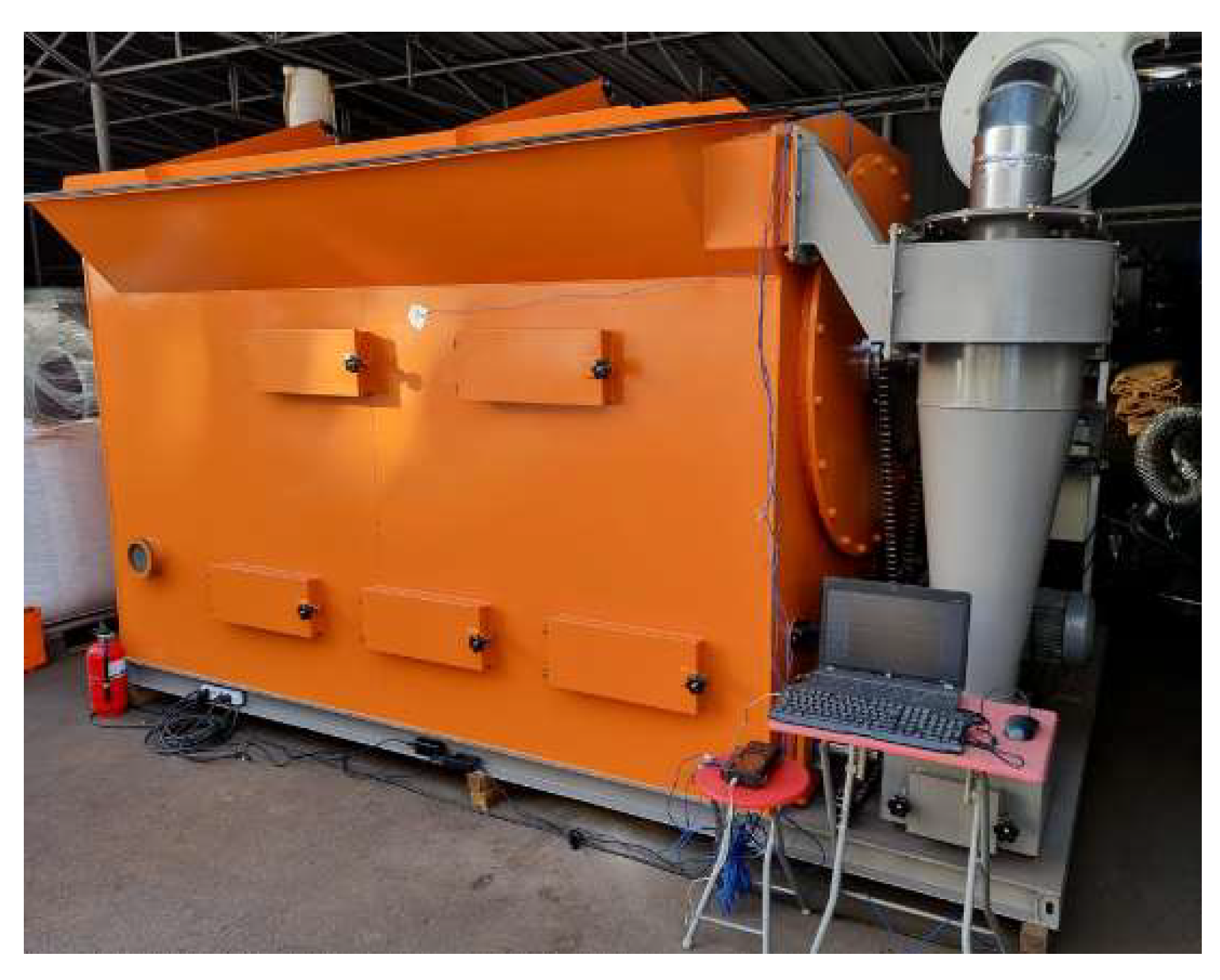
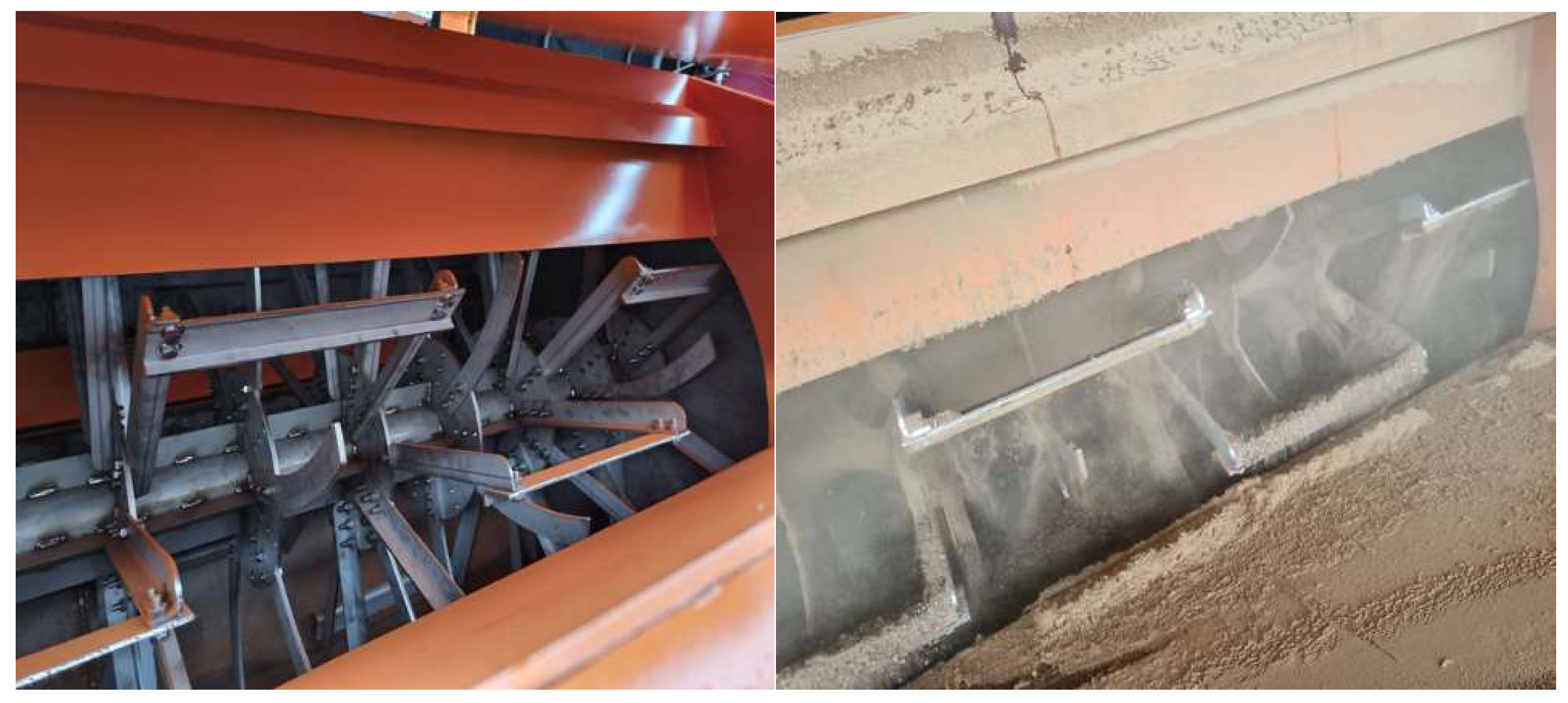


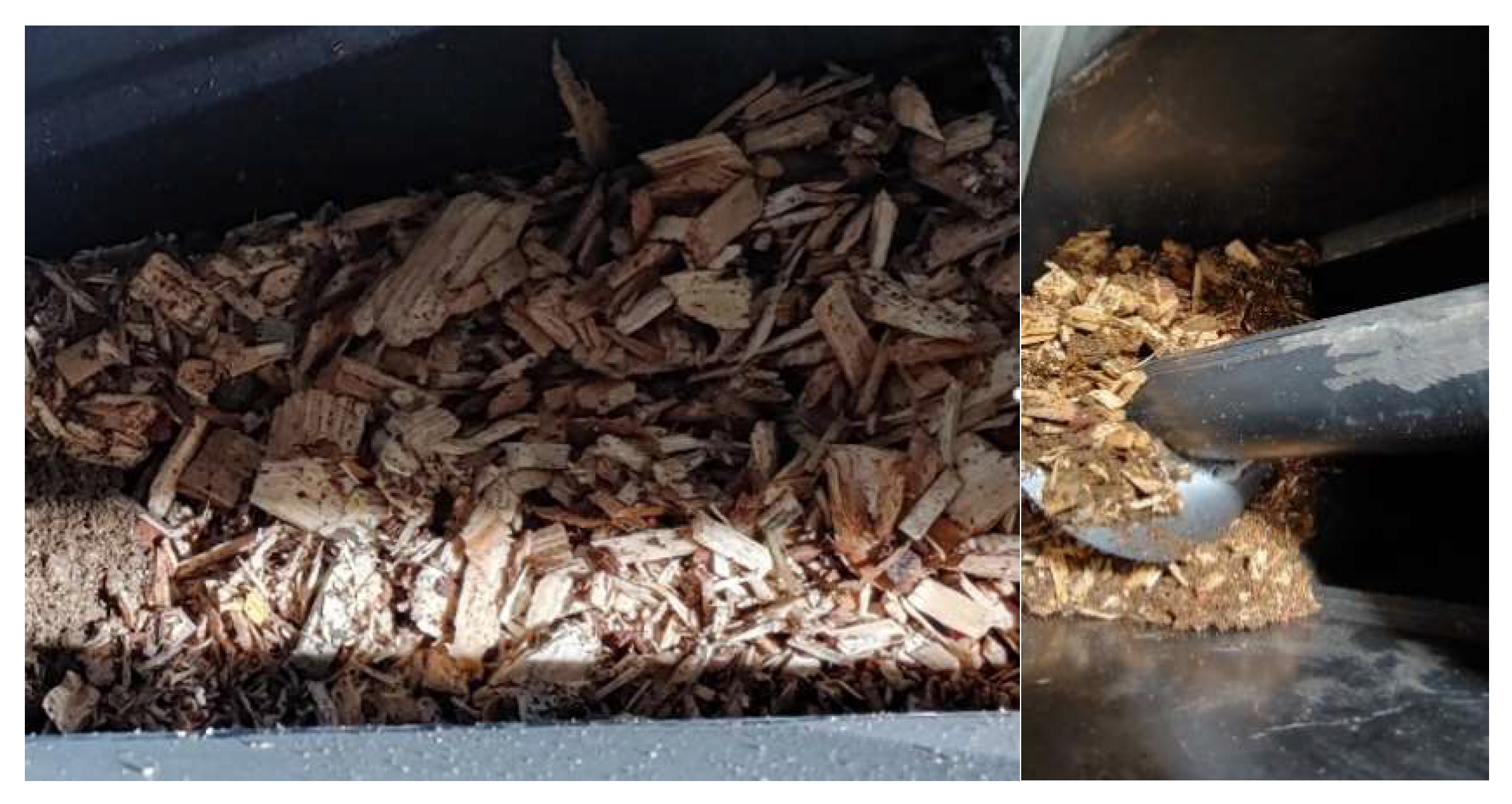
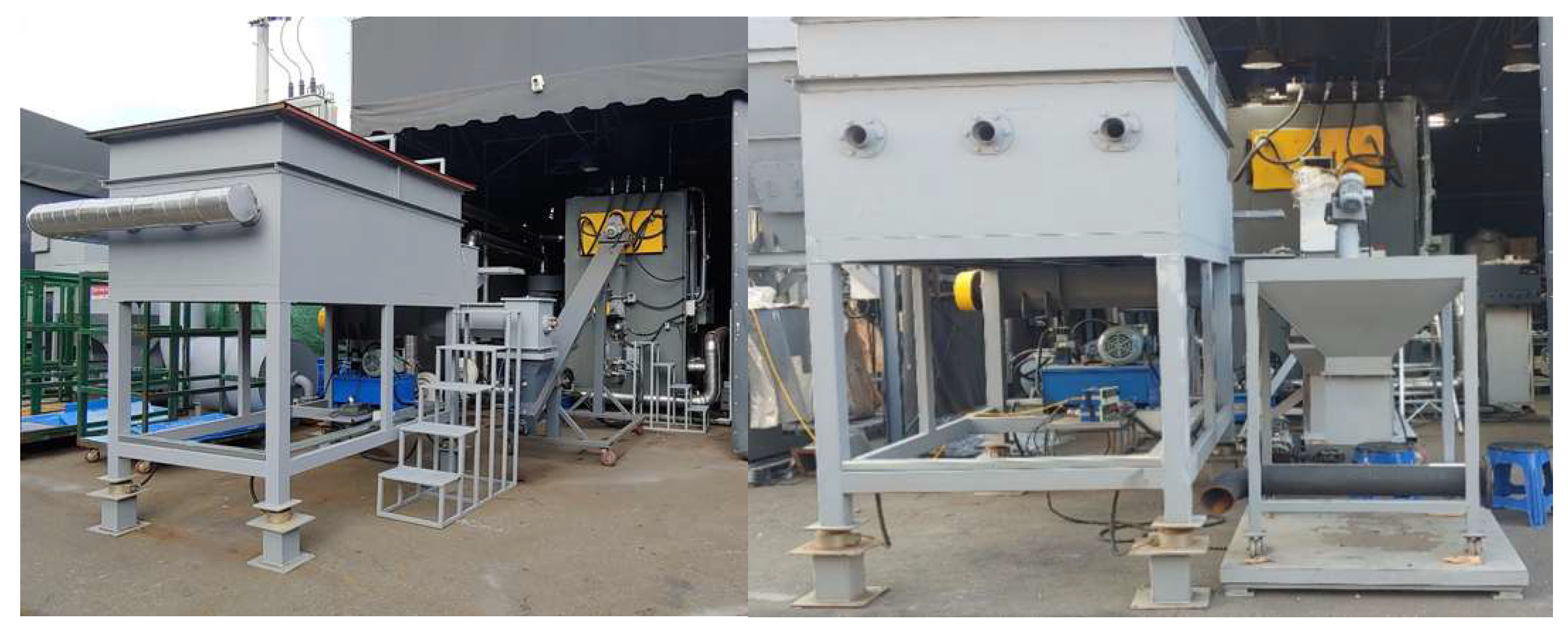

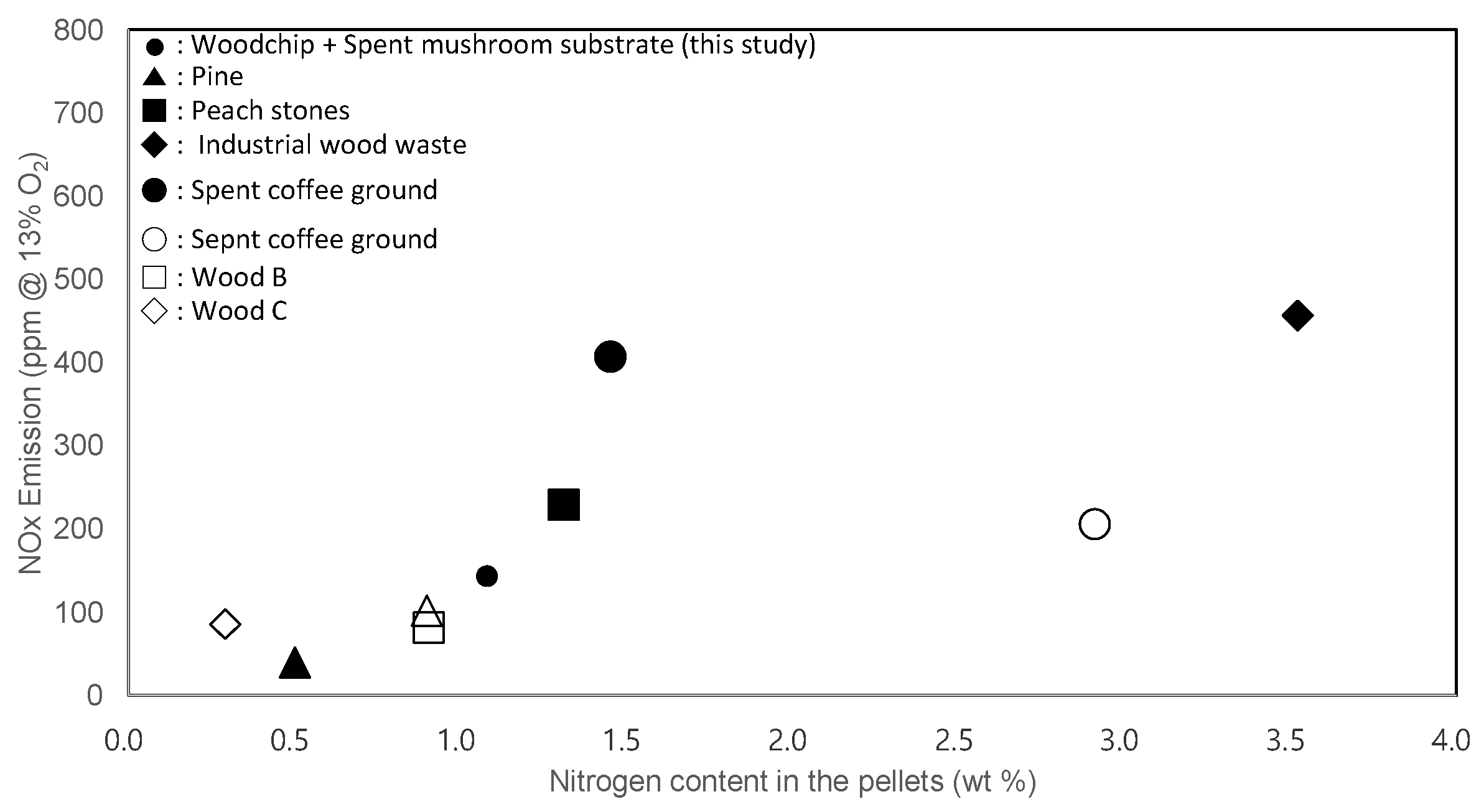
| Test Item | Unit | Woodchips | Spent Mushroom Substrate |
|---|---|---|---|
| Moisture | Mass % | 26.8 | 17.0 |
| Volatile matter | Mass % | 58.9 | 59.7 |
| Ash | Mass % | 0.8 | 14.8 |
| Carbon | Mass % | 49.8 | 38.2 |
| Hydrogen | Mass % | 6.1 | 5.2 |
| Nitrogen | Mass % | 0.3 | 2.6 |
| Sulfur | Mass % | 0.02 | 0.21 |
| Ash (Dry basis) | Mass % | 1.1 | 17.8 |
| Gross calorific value | kcal/kg | 3480 | 2989 |
| Net calorific value | kcal/kg | 3080 | 2664 |
| Fixed carbon | Mass % | 13.5 | 8.5 |
| Oxygen | Mass % | 42.67 | - |
| Fuel Type (Boiler Load) | Fuel Consumption Rate (kg/h) | O2 (%) | CO (ppm) | NOx (ppm) | Temperature of Combustor (°C) | Combustion Image |
|---|---|---|---|---|---|---|
| Woodchips (30%) | 66 | 14.0 | 172 | 45 | 765 | 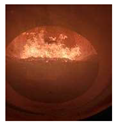 |
| Woodchips (50%) | 102 | 14.0 | 124 | 50 | 856 | 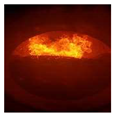 |
| Woodchips (70%) | 138 | 12.1 | 87 | 59 | 909 |  |
| Woodchips (100%) | 200 | 10.5 | 66 | 64 | 1103 | 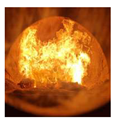 |
| Moisture Content (%) | Experiment 1 | Experiment 2 |
|---|---|---|
| Woodchips | 30.4 | 30.4 |
| Spent mushroom substrate | 45.2 | 20.7 |
| Fuel Load of Woodchips/SMS(%) | O2 (%) | CO (ppm) | NOx (ppm) | Temperature of Combustor (°C) | Combustion Image | |
|---|---|---|---|---|---|---|
| Experiment 1 | 70/30 | 17.3 | 2391 | 66 | 638 | 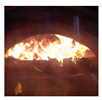 |
| Experiment 2 | 70/30 | 9.85 | 71 | 135 | 1049 |  |
Publisher’s Note: MDPI stays neutral with regard to jurisdictional claims in published maps and institutional affiliations. |
© 2022 by the authors. Licensee MDPI, Basel, Switzerland. This article is an open access article distributed under the terms and conditions of the Creative Commons Attribution (CC BY) license (https://creativecommons.org/licenses/by/4.0/).
Share and Cite
Lee, H.-H.; Kang, S.-B.; Choi, J.-J.; Youn, Y.-J.; Kim, K.-W.; Jeong, M.-S.; Byeon, J.-K. Co-Firing Combustion Characteristics of Woodchips and Spent Mushroom Substrates in a 400 kWth Stoker-Type Boiler. Energies 2022, 15, 9096. https://doi.org/10.3390/en15239096
Lee H-H, Kang S-B, Choi J-J, Youn Y-J, Kim K-W, Jeong M-S, Byeon J-K. Co-Firing Combustion Characteristics of Woodchips and Spent Mushroom Substrates in a 400 kWth Stoker-Type Boiler. Energies. 2022; 15(23):9096. https://doi.org/10.3390/en15239096
Chicago/Turabian StyleLee, Hyun-Hee, Sae-Byul Kang, Jae-Joon Choi, Young-Jik Youn, Kyu-Won Kim, Man-Soo Jeong, and Jae-Kyung Byeon. 2022. "Co-Firing Combustion Characteristics of Woodchips and Spent Mushroom Substrates in a 400 kWth Stoker-Type Boiler" Energies 15, no. 23: 9096. https://doi.org/10.3390/en15239096
APA StyleLee, H.-H., Kang, S.-B., Choi, J.-J., Youn, Y.-J., Kim, K.-W., Jeong, M.-S., & Byeon, J.-K. (2022). Co-Firing Combustion Characteristics of Woodchips and Spent Mushroom Substrates in a 400 kWth Stoker-Type Boiler. Energies, 15(23), 9096. https://doi.org/10.3390/en15239096






